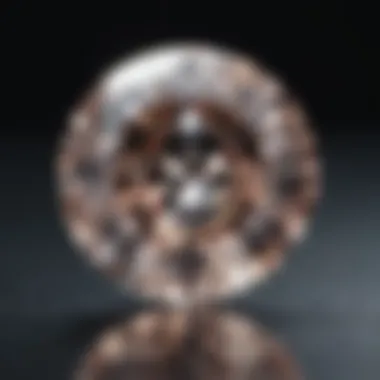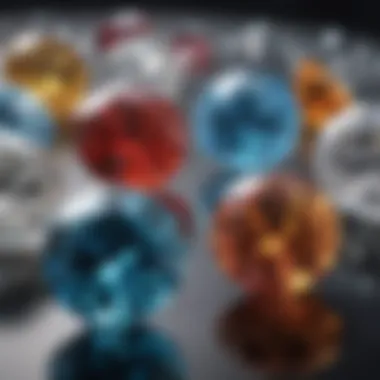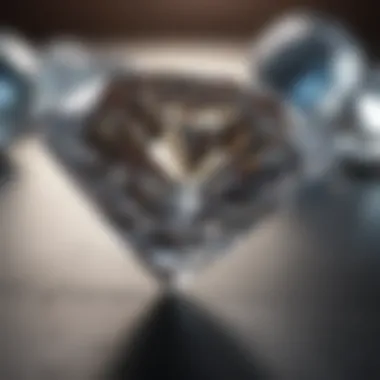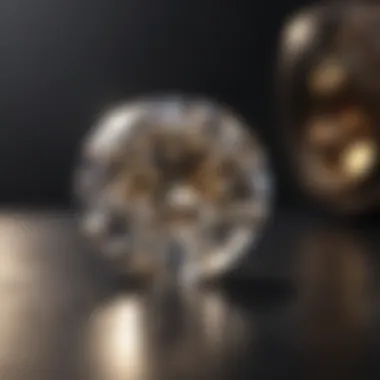Unveiling the Debate: Lab-Grown Diamonds - To Buy or Not to Buy?


Overview of Lab-Grown Diamonds
Lab-grown diamonds have revolutionized the traditional diamond industry, offering a sustainable and ethical alternative to mined diamonds. Understanding the nuances of lab-grown diamonds is essential for individuals contemplating a significant investment in these exquisite gemstones.
Pros and Cons of Lab-Grown Diamonds
Delving into the realm of lab-grown diamonds reveals a plethora of advantages and disadvantages. Unlike natural diamonds, lab-grown diamonds are created in controlled environments, ensuring minimal environmental impact and ethical concerns. However, some may argue that the lack of rarity and history associated with mined diamonds could depreciate their sentimental value.
Key Considerations Before Purchasing Lab-Grown Diamonds
Before delving into the world of lab-grown diamonds, it is crucial to consider various factors that can influence your buying decision. Factors such as price transparency, certification authenticity, and personal preferences in terms of size and quality play a significant role in determining the suitability of lab-grown diamonds for your needs.
Synthesizing Information
By exploring the pros and cons of lab-grown diamonds and understanding the key considerations before purchasing them, individuals can make informed decisions. The synthesis of information presented in this article equips readers with valuable insights to navigate the intricacies of the lab-grown diamond market and make well-informed choices.
Introduction
As we delve into the multifaceted world of diamonds, the topic of lab-grown diamonds emerges as a prominent consideration for prospective buyers. In this detailed exploration, we aim to shed light on the key aspects surrounding lab-grown diamonds, offering a comprehensive guide for those contemplating a purchase in the realm of gemstones.
Lab-grown diamonds, also known as synthetic diamonds, are man-made alternatives to natural diamonds, possessing identical physical and chemical properties. The growing interest in lab-grown diamonds stems from various factors, including ethical considerations, environmental impact, and cost-effectiveness, which we will scrutinize further in subsequent sections.


Understanding the nuances and differences between lab-grown and natural diamonds is crucial for making an informed decision when acquiring a valuable gemstone. By dissecting the creation process, chemical composition, and merits of lab-grown diamonds, we equip enthusiasts, collectors, and designers with the knowledge needed to navigate the complexities of the diamond market. Let us embark on this enlightening journey to unravel the mysteries and intricacies of lab-grown diamonds, paving the way for a well-informed choice in the intricate world of gemology.
Understanding Lab-Grown Diamonds
Lab-grown diamonds, a topic of increasing relevance and interest in the gemstone industry, play a pivotal role in the dynamic landscape of diamond selection. Understanding the intricacies of lab-grown diamonds is crucial for consumers looking to make informed decisions about their diamond purchases. By delving into the foundation of these gems, individuals can grasp the distinctiveness of lab-grown diamonds compared to their natural counterparts.
What Are Lab-Grown Diamonds?
Lab-grown diamonds, also known as synthetic diamonds, are created through advanced technological processes that replicate the natural diamond-growing environment. These diamonds possess the same chemical and physical properties as natural diamonds but are produced in a controlled setting rather than mined from the earth. The exceptional craftsmanship involved in crafting lab-grown diamonds results in gems that are visually identical to mined diamonds, offering a sustainable and ethical alternative in the jewelry market.
How Are Lab-Grown Diamonds Created?
The creation of lab-grown diamonds involves cutting-edge techniques that simulate the natural diamond formation process. By subjecting a tiny diamond seed to high pressure and temperature within specialized chambers, scientists can replicate the conditions found deep within the Earth's crust where diamonds are traditionally formed. This meticulous process is carried out with precision and expertise, ensuring the growth of high-quality diamonds that meet the rigorous standards of the gemstone industry.
Chemical Composition of Lab-Grown Diamonds
Lab-grown diamonds exhibit the same chemical composition as natural diamonds, composed of pure carbon arranged in a crystal lattice structure. This molecular resemblance enables lab-grown diamonds to showcase identical brilliance, durability, and fire as their mined counterparts. The controlled environment in which these diamonds are cultivated allows for consistency in quality, providing consumers with a reliable and sustainable option when considering diamond purchases.
Pros of Buying Lab-Grown Diamonds
In exploring the realm of lab-grown diamonds, it is imperative to weigh the pros that influence purchasing decisions significantly. Greater public awareness and shifting consumer preferences have catapulted lab-grown diamonds into the spotlight, driving a surge in demand for these ethically produced gems. One key element that sets lab-grown diamonds apart is their ethical considerations, which appeal to conscientious buyers looking to make a socially responsible choice. By delving into the ethical implications of diamond mining and opting for lab-grown alternatives, consumers contribute to minimizing the negative impacts associated with the traditional diamond industry.


Ethical Considerations
When it comes to ethical considerations surrounding lab-grown diamonds, transparency and traceability play pivotal roles in assuaging consumer concerns. Unlike mined diamonds, where issues like labor exploitation and environmental degradation are prevalent, lab-grown diamonds offer a more ethical alternative. Buyers can trace the origin of lab-grown diamonds, ensuring that their purchase aligns with ethical and sustainable practices. This transparency fosters trust and confidence in the product, resonating with ethical consumers who prioritize socially responsible choices.
Environmental Impact
The environmental impact of diamond mining is a significant point of contention in the jewelry industry. Traditional diamond mining often leads to deforestation, habitat destruction, and water pollution, posing grave threats to local ecosystems. In contrast, lab-grown diamonds require minimal environmental disruption, making them a greener choice for eco-conscious consumers. By opting for lab-grown diamonds, buyers can reduce their carbon footprint and support sustainable practices that mitigate environmental harm associated with diamond mining.
Cost-Effectiveness
Cost-effectiveness is another compelling factor that propels the popularity of lab-grown diamonds. Compared to natural diamonds, lab-grown alternatives offer a more budget-friendly option without compromising on quality or visual appeal. The streamlined production process of lab-grown diamonds results in lower overhead costs, translating into competitive pricing for consumers. This affordability makes lab-grown diamonds an attractive choice for budget-conscious buyers seeking high-quality gemstones at a lower price point.
Considerations Before Buying a Lab-Grown Diamond
When it comes to selecting a lab-grown diamond, certain fundamental considerations play a pivotal role in the decision-making process. In this insightful section, we delve into the critical aspects that buyers should weigh before investing in these gemstones. Quality and durability stand out as paramount factors that merit meticulous evaluation. Buyers are increasingly intrigued by the quality of lab-grown diamonds, seeking assurance that these stones are on par with their natural counterparts. Understanding the manufacturing processes and industry standards becomes crucial in assessing the quality of lab-grown diamonds. Durability adds another dimension to the decision-making process, with buyers keen on selecting diamonds that can withstand the test of time. Factors like hardness, toughness, and wear resistance come into play when assessing the durability of lab-grown diamonds. By exploring the nuanced interplay between quality and durability, buyers can make informed decisions that align with their preferences and values.
Quality and Durability
Quality serves as a cornerstone in the evaluation of lab-grown diamonds, reflecting the gemstone's intrinsic characteristics and visual appeal. Buyers seek diamonds that possess optimal clarity, color, and cut, factors that contribute to the overall beauty and brilliance of the stone. Understanding the grading systems used for lab-grown diamonds empowers buyers to make discerning choices based on objective criteria. Durability, on the other hand, highlights the diamond's ability to withstand daily wear and maintain its luster over time. Properties like hardness, measured on the Mohs scale, and toughness, indicating resistance to chipping and breakage, influence the durability of lab-grown diamonds. By prioritizing quality and durability, buyers can secure gems that not only dazzle with their aesthetic charm but also endure the rigors of daily wear.
Market Value and Resale Value


Analyzing the market value and resale potential of lab-grown diamonds forms a critical aspect of the purchasing decision. Buyers are increasingly conscious of the investment value of these gems, seeking assurances that their purchase will hold timeless worth. Understanding the factors that influence the market value of lab-grown diamonds, such as demand trends, technological advancements, and ethical considerations, equips buyers with the knowledge needed to navigate the gemstone market effectively. Resale value, on the other hand, reflects the potential return on investment that buyers can expect when reselling their lab-grown diamonds in the future. Factors like gemstone quality, market fluctuations, and consumer preferences play a pivotal role in determining the resale value of lab-grown diamonds. By delving into the intricate nuances of market and resale value, buyers can make strategic decisions that align with their long-term financial goals.
Comparing Lab-Grown Diamonds and Natural Diamonds
When considering the choice between lab-grown and natural diamonds, a critical aspect to examine is the comparison between their physical characteristics. It is imperative to delve into the nuances of these gemstones to make an informed decision on which type aligns best with one's preferences and values. Natural diamonds, formed over millions of years under the Earth's crust, exhibit distinct qualities resulting from their natural growth process. In contrast, lab-grown diamonds, created in artificial environments using advanced technology, boast characteristics that set them apart in terms of clarity, color, and overall appearance.
Physical Characteristics
The physical attributes of diamonds are integral to their value and allure. Natural diamonds typically come with unique imperfections known as inclusions, which can affect their clarity and brilliance. On the other hand, lab-grown diamonds are often hailed for their exceptional clarity due to the controlled environment in which they are grown, minimizing inclusions. Additionally, the color of diamonds is a key factor in determining their beauty and value. Natural diamonds display a wide range of hues, from colorless to fancy colors, influenced by elements present during their formation. In contrast, lab-grown diamonds exhibit consistent color quality, with manufacturers able to produce specific colors based on consumer preferences.
Emotional Value
Beyond their physical characteristics, diamonds hold significant emotional value for many individuals. Natural diamonds carry a sense of tradition and history, symbolizing milestones such as engagements and anniversaries. The idea of wearing a diamond that has endured billions of years in the Earth's mantle can evoke a sense of timelessness and rarity. On the other hand, lab-grown diamonds are celebrated for their eco-friendly origin and ethical production process, appealing to those conscious of environmental impact and sustainability. The emotional value of lab-grown diamonds lies in their modernity and innovation, reflecting a shift towards more responsible practices in the jewelry industry.
Making an Informed Decision
When delving into the realm of lab-grown diamonds, one crucial aspect demands our attention: making an informed decision. This pivotal step holds the key to unlocking a world of ethical considerations, environmental impact evaluations, and financial assessments. Understanding the nuances between lab-grown and natural diamonds is not merely a choice but a profound decision that reflects individual values and preferences.
In the context of this article, 'Making an Informed Decision' serves as the lynchpin, bridging theoretical knowledge with real-world applications for potential buyers and enthusiasts alike. By dissecting the quality, durability, market value, and resale potential of lab-grown diamonds, readers can navigate the gemstone market with acuity and foresight. This section aims to empower individuals with the requisite knowledge to discern between the intricate facets of lab-grown diamonds and make a judicious choice that aligns with their beliefs and objectives.
Quality emerges as a paramount consideration when contemplating the acquisition of lab-grown diamonds. By unraveling the metrics of cut, clarity, color, and carat weight, buyers can gauge the intrinsic value of these lab-created gems. Moreover, assessing the durability and long-term performance of lab-grown diamonds vis-a-vis natural counterparts sheds light on their suitability for everyday wear and special occasions.
Market value and resale potential loom large in the decision-making process, underscoring the need for a thorough examination of pricing trends and industry dynamics. Understanding how lab-grown diamonds fare in the secondary market and their comparative value proposition against natural diamonds unlocks a realm of strategic insight for buyers seeking not just instant gratification but lasting value.
In essence, 'Making an Informed Decision' elevates the discourse surrounding lab-grown diamonds to a realm of meticulous evaluation and prudent judgment. By immersing readers in a comprehensive analysis of essential factors and variables, this section equips them with the tools to navigate the dynamic landscape of gemstone acquisitions with confidence and sagacity.
Conclusion
Lab-grown diamonds present a compelling option in the realm of gemstones, offering a unique blend of innovation and ethical considerations. As the diamond industry evolves, consumers are increasingly drawn to the benefits that lab-grown diamonds bring to the table. One of the key aspects to consider when contemplating the purchase of a lab-grown diamond is the ethical dimension. Unlike traditional mined diamonds, lab-grown diamonds have a significantly lower environmental impact, making them a preferred choice for environmentally-conscious buyers. Furthermore, the cost-effectiveness of lab-grown diamonds cannot be overstated. With prices generally lower than natural diamonds, consumers can attain a stunning piece of jewelry without breaking the bank. When evaluating lab-grown diamonds for purchase, considerations of quality and durability come to the forefront. Many consumers are pleasantly surprised to find that lab-grown diamonds exhibit the same physical and chemical properties as natural diamonds, ensuring excellent durability and beauty. Market and resale value also play a crucial role in the decision-making process. While lab-grown diamonds may not hold the same monetary value as natural diamonds, their market share continues to grow, signaling a strong future for these gemstones. Synthesizing the information presented in this article, opting for a lab-grown diamond is a choice that aligns with ethical, environmental, and budgetary considerations. By prioritizing quality and understanding the evolving market trends, consumers can make an informed decision that not only reflects their values but also embraces innovation in the diamond industry.







